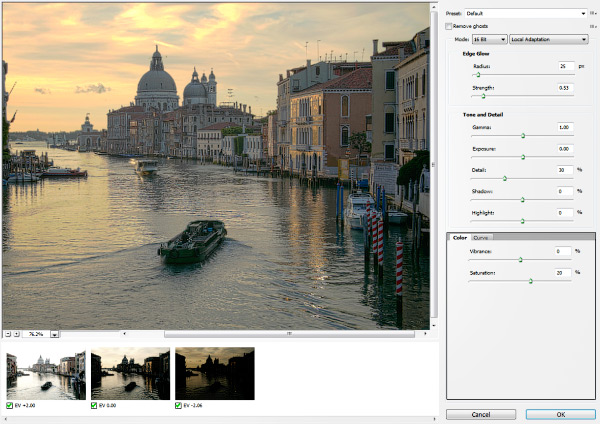 This HDR Photoshop tutorial covers improvements and new features related to HDR photo processing in Photoshop CS5. Improved HDR workflow in Photoshop CS 5 is called HDR Pro. HDR pro provides extended controls over the HDR merging process, improved image processing and tone mapping adjustments. The styling of HDR output presets varies from photorealistic to hyper-realistic high contrast HDR images. HDR Pro also improves source files alignment and adds automatic deghosting feature. With Photoshop CS5 you can finally create the look of an HDR-processed image from a single photo with the new HDR Toning feature. This is the second tutorial (check out Content aware Photoshop CS5 tutorial) in the series of tutorials focused on Photoshop CS5 new features.
This HDR Photoshop tutorial covers improvements and new features related to HDR photo processing in Photoshop CS5. Improved HDR workflow in Photoshop CS 5 is called HDR Pro. HDR pro provides extended controls over the HDR merging process, improved image processing and tone mapping adjustments. The styling of HDR output presets varies from photorealistic to hyper-realistic high contrast HDR images. HDR Pro also improves source files alignment and adds automatic deghosting feature. With Photoshop CS5 you can finally create the look of an HDR-processed image from a single photo with the new HDR Toning feature. This is the second tutorial (check out Content aware Photoshop CS5 tutorial) in the series of tutorials focused on Photoshop CS5 new features.
To start with this HDR Photoshop tutorial you need at least three photos with different exposures of the same scene.
Merge images to HDR
1. In Photoshop, choose File -> Automate -> Merge To HDR Pro. In the Merge to HDR Pro dialog box, click Browse to select specific images, click Add Open Files, or choose Use -> Folder.

In Bridge, select the images you want to use and choose Tools -> Photoshop > Merge To HDR.
2. If you didn’t use tripod and held the camera in your hands when you took the images, select Attempt to Automatically Align Source Images
If images don’t have exposure metadata in EXIF, set corresponding values in Manually Set EV dialog box.
3. The next Merge to HDR Pro dialog box appears displaying source images thumbnails as well as preview of the merged result. While 32-bit images save all the dynamic range of HDR scene, there’s currently no way to process it further in Photoshop CS5.
Tone Mapping
In the upper right of the preview, choose 16- bit depth for the merged image and Local Adaptation tone-mapping method.

You will have a number of presets (13) to choose from including variations of photorealistic, surreal and monochromatic. None of them works perfectly by default, though it’s a good starting point to understand how different settings have control over the look of your HDR image. Here’s description of most important settings you can tweak.
Edge Glow Radius and Strength are main control of the HDR look. You can achieve the desired look by just increasing and changing these parameters.
Tone and Detail slider adjusts sharpness, Gamma reflect f-stops and Exposure emphasize midtones or highlights and shadows.
Toning Curve is very similar to Photoshop Curves.
4. If the images you’ve taken have any moving objects such as cars or people, select Remove Ghosts in the Merge to HDR Pro dialog box. You need to have at least 3 images to “Remove Ghosts”, otherwise this option will be grayed out.
Photorealistic HDR preset

Surrealistic HDR preset

You can compare how the same scene looks in Photomatix and as Realistic HDR
HDR single image tone mapping
In Photoshop CS5 you can apply HDR tone mapping to a single image to achieve HDR look.
After you open your image in Photoshop CS5, choose Image -> Adjustments -> HDR Toning.
The dialog box and settings are the same as in the previous step.